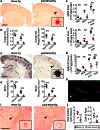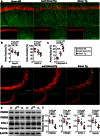Physiological amyloid-beta clearance in the periphery and its therapeutic potential for Alzheimer's disease
- PMID: 26363791
- PMCID: PMC4575389
- DOI: 10.1007/s00401-015-1477-1
Physiological amyloid-beta clearance in the periphery and its therapeutic potential for Alzheimer's disease
Abstract
Amyloid-beta (Aβ) plays a pivotal role in the pathogenesis of Alzheimer's disease (AD). The physiological capacity of peripheral tissues and organs in clearing brain-derived Aβ and its therapeutic potential for AD remains largely unknown. Here, we measured blood Aβ levels in different locations of the circulation in humans and mice, and used a parabiosis model to investigate the effect of peripheral Aβ catabolism on AD pathogenesis. We found that blood Aβ levels in the inferior/posterior vena cava were lower than that in the superior vena cava in both humans and mice. In addition, injected (125)I labeled Aβ40 was located mostly in the liver, kidney, gastrointestinal tract, and skin but very little in the brain; suggesting that Aβ derived from the brain can be cleared in the periphery. Parabiosis before and after Aβ deposition in the brain significantly reduced brain Aβ burden without alterations in the expression of amyloid precursor protein, Aβ generating and degrading enzymes, Aβ transport receptors, and AD-type pathologies including hyperphosphorylated tau, neuroinflammation, as well as neuronal degeneration and loss in the brains of parabiotic AD mice. Our study revealed that the peripheral system is potent in clearing brain Aβ and preventing AD pathogenesis. The present work suggests that peripheral Aβ clearance is a valid therapeutic approach for AD, and implies that deficits in the Aβ clearance in the periphery might also contribute to AD pathogenesis.
Keywords: Alzheimer’s disease; Amyloid-beta; Clearance; Kidney; Liver; Parabiosis; Periphery.
Figures




References
-
- Bradshaw EM, Chibnik LB, Keenan BT, Ottoboni L, Raj T, Tang A, Rosenkrantz LL, Imboywa S, Lee M, Von Korff A, Alzheimer Disease Neuroimaging I. Morris MC, Evans DA, Johnson K, Sperling RA, Schneider JA, Bennett DA, De Jager PL. CD33 Alzheimer’s disease locus: altered monocyte function and amyloid biology. Nat Neurosci. 2013;16:848–850. doi: 10.1038/nn.3435. - DOI - PMC - PubMed
-
- Bu XL, Yao XQ, Jiao SS, Zeng F, Liu YH, Xiang Y, Liang CR, Wang QH, Wang X, Cao HY, Yi X, Deng B, Liu CH, Xu J, Zhang LL, Gao CY, Xu ZQ, Zhang M, Wang L, Tan XL, Xu X, Zhou HD, Wang YJ. A study on the association between infectious burden and Alzheimer’s disease. Eur J Neurol. 2014 - PubMed
Publication types
MeSH terms
Substances
LinkOut - more resources
Full Text Sources
Other Literature Sources
Medical

